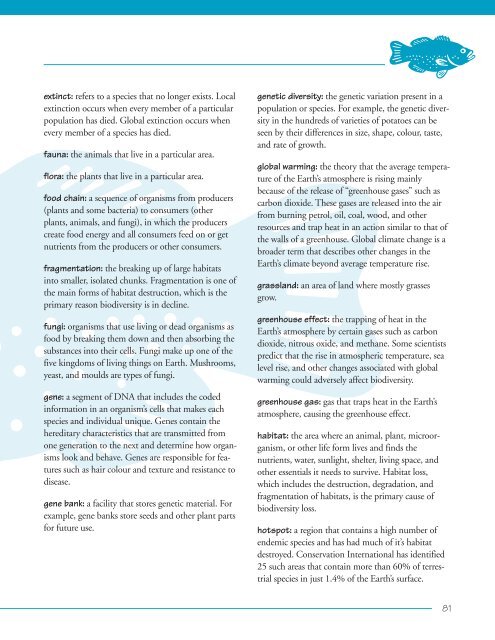EXPLORING BIODIVERSITY: A Guide for Educators Around the World
EXPLORING BIODIVERSITY: A Guide for Educators Around the World
EXPLORING BIODIVERSITY: A Guide for Educators Around the World
Create successful ePaper yourself
Turn your PDF publications into a flip-book with our unique Google optimized e-Paper software.
extinct: refers to a species that no longer exists. Local<br />
extinction occurs when every member of a particular<br />
population has died. Global extinction occurs when<br />
every member of a species has died.<br />
fauna: <strong>the</strong> animals that live in a particular area.<br />
flora: <strong>the</strong> plants that live in a particular area.<br />
food chain: a sequence of organisms from producers<br />
(plants and some bacteria) to consumers (o<strong>the</strong>r<br />
plants, animals, and fungi), in which <strong>the</strong> producers<br />
create food energy and all consumers feed on or get<br />
nutrients from <strong>the</strong> producers or o<strong>the</strong>r consumers.<br />
fragmentation: <strong>the</strong> breaking up of large habitats<br />
into smaller, isolated chunks. Fragmentation is one of<br />
<strong>the</strong> main <strong>for</strong>ms of habitat destruction, which is <strong>the</strong><br />
primary reason biodiversity is in decline.<br />
fungi: organisms that use living or dead organisms as<br />
food by breaking <strong>the</strong>m down and <strong>the</strong>n absorbing <strong>the</strong><br />
substances into <strong>the</strong>ir cells. Fungi make up one of <strong>the</strong><br />
five kingdoms of living things on Earth. Mushrooms,<br />
yeast, and moulds are types of fungi.<br />
gene: a segment of DNA that includes <strong>the</strong> coded<br />
in<strong>for</strong>mation in an organism’s cells that makes each<br />
species and individual unique. Genes contain <strong>the</strong><br />
hereditary characteristics that are transmitted from<br />
one generation to <strong>the</strong> next and determine how organisms<br />
look and behave. Genes are responsible <strong>for</strong> features<br />
such as hair colour and texture and resistance to<br />
disease.<br />
gene bank: a facility that stores genetic material. For<br />
example, gene banks store seeds and o<strong>the</strong>r plant parts<br />
<strong>for</strong> future use.<br />
genetic diversity: <strong>the</strong> genetic variation present in a<br />
population or species. For example, <strong>the</strong> genetic diversity<br />
in <strong>the</strong> hundreds of varieties of potatoes can be<br />
seen by <strong>the</strong>ir differences in size, shape, colour, taste,<br />
and rate of growth.<br />
global warming: <strong>the</strong> <strong>the</strong>ory that <strong>the</strong> average temperature<br />
of <strong>the</strong> Earth’s atmosphere is rising mainly<br />
because of <strong>the</strong> release of “greenhouse gases” such as<br />
carbon dioxide. These gases are released into <strong>the</strong> air<br />
from burning petrol, oil, coal, wood, and o<strong>the</strong>r<br />
resources and trap heat in an action similar to that of<br />
<strong>the</strong> walls of a greenhouse. Global climate change is a<br />
broader term that describes o<strong>the</strong>r changes in <strong>the</strong><br />
Earth’s climate beyond average temperature rise.<br />
grassland: an area of land where mostly grasses<br />
grow.<br />
greenhouse effect: <strong>the</strong> trapping of heat in <strong>the</strong><br />
Earth’s atmosphere by certain gases such as carbon<br />
dioxide, nitrous oxide, and methane. Some scientists<br />
predict that <strong>the</strong> rise in atmospheric temperature, sea<br />
level rise, and o<strong>the</strong>r changes associated with global<br />
warming could adversely affect biodiversity.<br />
greenhouse gas: gas that traps heat in <strong>the</strong> Earth’s<br />
atmosphere, causing <strong>the</strong> greenhouse effect.<br />
habitat: <strong>the</strong> area where an animal, plant, microorganism,<br />
or o<strong>the</strong>r life <strong>for</strong>m lives and finds <strong>the</strong><br />
nutrients, water, sunlight, shelter, living space, and<br />
o<strong>the</strong>r essentials it needs to survive. Habitat loss,<br />
which includes <strong>the</strong> destruction, degradation, and<br />
fragmentation of habitats, is <strong>the</strong> primary cause of<br />
biodiversity loss.<br />
hotspot: a region that contains a high number of<br />
endemic species and has had much of it’s habitat<br />
destroyed. Conservation International has identified<br />
25 such areas that contain more than 60% of terrestrial<br />
species in just 1.4% of <strong>the</strong> Earth’s surface.<br />
81

















